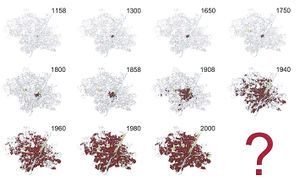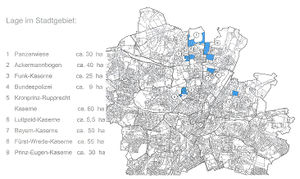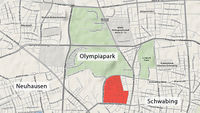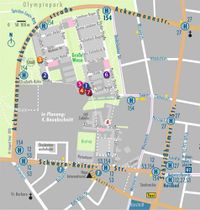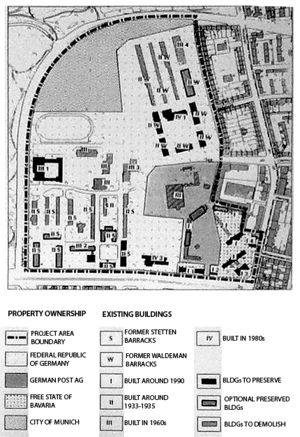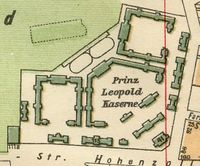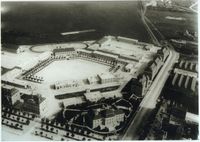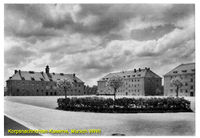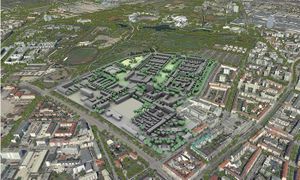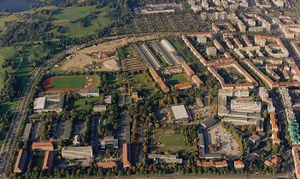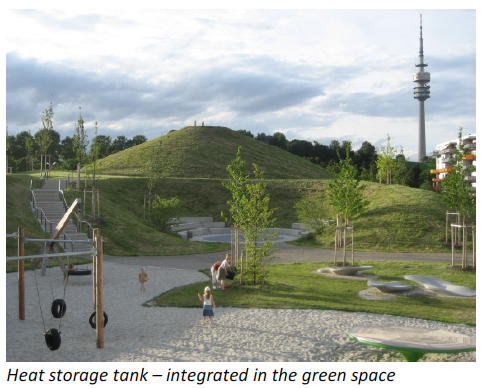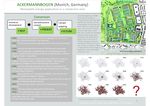Group O - Collaborative Climate Adaption Project
| Area | Munich | |
| Place | Ackermannbogen | |
| Country | Germany | |
| Topic | renewable energy application | |
| Author(s) | Cenke Jiang, Andreea Pascu, Le Trang Nguyen | |
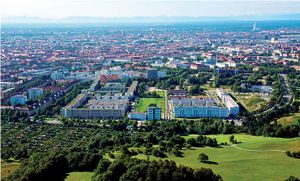
| ||
|
| ||
Rationale: Why have you selected this case study area?
- Munich is the capital city of Bavaria, one of Germany's three largest cities with the population of 1.42 million people and has the strongest economy of the whole country. This is a globally cosmopolitan city and also has the leading renewable energy policy.
- Ackermannbogen is a district of Munich particularly planned to be one of the front-runners of solar district heating. This is a part of the city's aim: 100% renewable energy for Munich in 2015. This area is a perfect practical example of building a green enery system and an innovative concept of intergrating solar heating machines with green space.
- The scale of the area is large enough to reflect the changing of climate upon it, but not too immense to propose detailed and practical solutions. Also although our seminar platform is international, at least two of us can approach the site in Germany and German resources; the result of our research can be then directly re-confirmed and feedbacked by a large group of German participants.
Authors' perspectives
- One interesting feature of urban development history of Germany is the areas called "Conversion areas". Since the beginning of 1990s the troops of Germany’s Federal Armed Forces had been significantly reduced, that consequently led to the free land use from military in many German cities. The conversion started from the high urban needs, then soon realised its ecological potential. Many areas were converted into residential or public areas in the sense of climate changing awareness and became living area model (e.g: Vauban in Freiburg, Halles in Saale, Patrick-Henry village in Heidelberg...etc). Ackermannbogen maybe one of the most well-known and well-done conversion due to its scale and perpective, and still in "adapting" progress. In our opinion, this type of conversion is the right attitude and action connecting history-presence-future of an area.
- We all come from different background (architecture and landscape architecture), but our aspirations meet where the climate is actually changing and we believe renewable energy and mitigation is the key solution for the future. We chose Ackermannbogen as a project-case study, more than a reality-case study, because it is a great project which was designed and currently being built and continually adjusted for the future. Our aim is to learn from such massive plan and to make our own proposals in the context of pre-designed but considering the factor of climate changing.
Landscape and/or urban context
In the late eighties, the city of Munich laid the foundation stone for a municipal policy committed to promoting renewable sources of energy by emphasising energy saving. As early as 1991, the Munich municipal council decided to concentrate on lowering CO2 emissions by 30% in 2005 and by 50% in 2010. So far, the City of Munich's climate protection policy has respected Kyoto protocol objectives even though this was not the case before they were defined.
Ackermannbogen district, or the former Waldmann Stetten barracks was planned at that time. In a very attractive location next to the Olympic Park and adjacent to Schwabing area, it offers the ability to resolve arisen urban deficiency and to make an important contribution for housing in Munich. In May 1992, the first step toward redevelopment of the site was already done. The city of Munich took the "decision to initiate urban development action on the area of the Waldmann Stetten barracks". This was followed in June 1994, a structure plan for the area of the barracks was made and a year later the consequent establishment of a comprehensive site report, created by the architects Dragomirand landscape architects Stahr + Haberland. As part of this opinion, urban and landscape planning conditions and the state of civil structures were investigated and evaluated.
In February 1995, the decision of the Ministerial Council of the Free State of Bavaria followed, the Waldmann-Stetten barracks was carried on in the program "Bavarian Future, settlement models - new ways to economical, ecological and social housing in Germany". Based on these foundations, in July 1996, the City Planning Department in Munich announced an urban design and landscape design idea competition for building and landscape architects.
In 1998, the architect Christian Vogel and landscape architect Rita Lex Kerfers won the first prize. The central design idea of the community planning was to create a wide range of different housing types - from double or terraced houses to apartment buildings. In the same year, for the development of the area planning, the city of Munich set all properties on the site for sale and appropriately restricted to private investor purchase.
Overall character
The project area is located in the northern part of the Neuhausen-Oberwiesenfeld district in the north of Munich, close to the southern edge of the Olympic site and connects directly to the Schwabing district. It is bounded by the Ackermann Road to the west, the Deidesheimer to the north, Saar and Winzererstraße the east and Schwere–Reichter Road in the south.
To the south from the Schwere–Reichter Road, there is another smaller and still-in-used barracks (Luitpold barracks); another small, self-contained residential subdivision and several gas stations. Extended from this area are official buildings and public facilities (located on Infantry Road, Hess Road, Loth Road and Dachauer Road).
In the east side of the project area is the Schwabing-West district with a dense block-buliding structure. Further to the north, the Middle Ring, [Äußerer Ring (München)Frankfurter Ring] create a business and industrial belt, making an urban barrier from the available landscape freedom.
This area is not far from surrounding significant areas, easily reached by trains, buses and tram system:
- approx. 3km from the City centre
- approx. 2km from München Freiheit
- approx. 1,5km from Luitpold Park
- approx. 3km from English Garden
This convenient location therefore requires an attractive planning for both residents and visitors, which is quite challenging due to the expected high-used pressure.
Land use
The range of the Waldmann Stetten barracks' development planning covers an area of 39.5 hectares, of which approx. are:
- 16.4 hectares as former Stetten barracks, owned by the Federal Republic of Germany
- 5.6 hectares owned by the city of Munich
- 4.5 hectares belong to Deutsche Post AG
- 2.3 ha the state of Bavaria (1)
Within the Urban Development Action, till 2014 Ackermannbogen will then cover 39.5 hectares in total:
- ca. 2250 dwellings
- Student dormitory
- Kindergarten
- Public primary school
- Private school
- Medical centre
- Supermarket
- Retails, Cafeterias
- Cultural and neighborhood meeting
- Bridge Construction
- 9.2 hectares of public green spaces
- Large meadow
- Playground
- Hills
- City Forest
Biogeography
The planning area is located in the Munich gravel plain on the terraces of the Würm glaciation. It is flat and inclined slightly from 514m in the north to 513m in the south.
The most important for this work natural environment bases from the site report by Dragomir, Stahr and Naberland are (1995) summarized:
• Ground
On the ground conditions in the narrow city there are no statements of location-known 'land map, because the soils in the city mostly by dumping of strange substances and building materials which are no longer in its natural state.
• Groundwater
The ground in the planning area, as well as the entire Munich gravel plain, is very porous and therefore has significant groundwater resources, including drinking water supply. From the built-over and paved surfaces, the surface water flows through sewerage drains, the river Isar supplies and directs water from the urban area . It is therefore very important to keep in newly developed areas the soil sealing as little as possible.
• Climate
There is low weather exchange from the south and the east due to weak winds, since the planning area is bordered by densely built-up and busy streets. Only the meadows of the Olympic mountain can be seen as the original area of unpolluted cold air. Especially in weak-wind radiation nights, fresh air can flow from the Olympic mountains towards the center of the area.
A climate-ecological balance function also exerts from the meadows and the richly textured mature trees on the site plan.
• Trees
In the planning area, there are valuable trees, which mainly consists of about 60-80 years old sycamore and Norwegian maples and lime trees. The trees have mostly good vigor and a magnificent disposition, most are under the Munich Tree Protection Ordinance (trunk circumference> 80 cm, height> 1m).
• Habitats
There is a former heliport in the planning area. It consists of a gravel surface on which a dry vegetation has developed over the years developed, bordered by woodland nursery. In 1981 this area was mapped as a 0.7 ha sized legitimate habitat. Since then the habitat has expanded twice as large.
In the south of the Olympic Park there are poor grassland habitats on former railway land and extensive sand hill areas. Between habitats through the narrow neighborhood of the former helipad is a floristic and faunal exchange. The area of the helipad has therefore the ecological value of a stepping-stone habitat.
• Fauna
Conspicuously on the planning area is the birdlife, which is mainly due to the old trees with its richly structured tree groups adjacent to Olympic Park. Among others it is possible to spot species of blackbirds, chickadees, spotted woodpeckers, pheasants, ducks and hawks.
Rare animals can be found primarily in the area of the former helipad. The animal varies from various ants, butterflies and grasshoppers.
History and dynamics
The barracks in Oberwiesenfeld
The history of the whole area comes from the land named Oberwiesenfeld. Since the late 18th century, city's barracks had been dismissed, or replaced in northwest Munich, the military then focused in Oberwiesenfeld, at that time covered an area which corresponds roughly to the present Dachauer Road in the west, Moosacher Road in the north and Schleißheimer Road in the east. (2)
The history of the whole area comes from the land named Oberwiesenfeld. Since the end of the 19th century, Oberwiesenfeld area had been the landing for balloons and airships, both military and civilian. Till 1902 Prince Luitpold established the Prinz Leopold barracks extending from Infanterie Road to Schwere-Reiter Road, which forms today the southern tip of the planning area. By the corner of Schwere-Reiter Road and Winzerer Road are the preserved historical buildings, including the Department of Transportation (Straßenbauamt), the State Archives (Staatsarchiv) and a cafetaria was located.
Adjacent to the planning area to the north of the Dachauer Road was the area of the railway company since 1890, on which the buildings of Munich’s Military Adminstration and Site Management are currently erected, together with the district recruiting office . Since 1896, a new barrack was built in the south of Schwere-Reiter Road, at the corner of Heß Road and an airship department was located, which was later expanded to Luitpold barracks by the Nazis. In 1909, a small condominium for army officials was built in the south of Schwere-Reiter Road, at Barbara Road and still preserved till today. Also under the Nazis time the military had added to existing military building regulations: in 1933, the first part of the "motorcycle-shooters-barracks" (Kraftrad-Schützen-Kaserne) was built in the west of existing Prinz-Leopold barrack. Since 1935 the New-corps barrack errected, today known as Waldmann barrack. Here till the 2nd World War was the accommodation of infantries, pioneers, signal corps and drivers. After the end of the 2nd World War, the planning area was only slightly damaged and some facilities as emergency shelters for refugees and expellees were installed; they also have been used temporarily for commercial purposes.
The barracks were occupied by U.S. forces from 1945 to the late 50s and then claimed against the Federal Army Force. New supplemental buildings were added gradually to the site of the Stetten barracks in 1960s: Auditorium buildings, dorm and gymnasiums. In the same period there was a central heating plant with brick chimney in the middle of the site, to reflect similar architectural style of the whole area. The Waldmann barracks were removed from the grounds for that reason.
The further development of Oberwiesenfeld
After the World War II, in 1951, a 40-meter high pile of rubble from the war’s ruins was dumped in the south of the Nymphenburg Biederstain-canal. This separated the south-eastern part of the Oberwiesenfeld; the spatial connection between this area (nowadays planning area) and the rest of Oberwiesenfeld was lost.
In April 1966, Munich was decided to host the Olympic Summer Games '72. The rubble pile was used as an element in the landscaping concept of the Olympic facilities (3). The Olympic Park was completed in June 1972. Since 1972, the northern (and largest) part of the Oberwiesenfeld was merged into Munich Olympic Park.
The current use of Waldmann-Stetten barracks
Then for the area under the name "am Ackermannbogen" urban planning began to reflect a part of the Prince Leopold Barracks, both of which are currently completed three sections. After the construction of the first section in the north east of the site, the building of the Department of Military Geography (MilGeo) which had been abandoned by the army then was reconstructed. In 2006/07 the former barracks building in the Stetten barracks were pulled down, whereupon the fourth section will be built next to the student dormitory at Schweren-Reiter street.
Based on the urban contract and development agreement between the property owners and the City of Munich, in the fall of 2002 the first section of the development and the construction of housing in Ackermannbogen started. The northeast neighborhood was constructed under the "Bavarian Future", a residential support program of the Free State of Bavaria, which implemented as a "model village" to try new ways of cost, environmental and social living in Bavaria. Here approximately 630 homes, a mixture of various types of houses and apartments, as well as a daycare center were realized. Another building on the north end of the large lawn with an integrated cooperative system for children is expected to be ready in spring 2007.
The third section (North-West district) is the model project implemented Solar local heating, or solar thermal energy and district heating. Three large underground storage tanks were placed to supply approximately 300 residential units.
In the south (second section), particularly along Schwere-Reiter street and in the northern part of the Adams-Lehmann-street, next to social housing and public service and high-priced condominiums, a health clinic and a day care center are planned.
In the southwest (fourth section, there is a "market square" and the shops and stores are grouped so that the new district is supplied accordingly. In this area there will be sheltered housing for the arising elderly. An existing building on the Schwere-Reiter street was converted into a dormitory. The development plan for the fourth section is still being considered and not decided yet.
Ratio of green/blue and sealed/built-up areas
Illustration: Map; sketches; short descriptive analyses
Cultural/social/political context
- Brief explanation of culture, political economy, legal framework
Domestic culture and lifestyle have developed over time in the newly-built district. Fifteen years ago, the city set the course for the conversion project which was to develop the site of the former Waldmann and Stetten Barracks south of the Olympic Park into a residential and working district for 5,000 up to 6,000 people with some 500 jobs. So the new city district was planned on the drawing board in Schwabing-West, just three kilometres from the city centre. That meant that the inhabitants of the first section needed great imagination and pioneering spirit. Although many hopes and wishes were pinned on the emerging new city district, hardly anyone could imagine at first how it might turn out in the future. After the difficult early years when planning deficiencies emerged, such as a lack of schools, the overall concept of the city is now back on track, not least through civic involvement. Various municipal funding measures that awarded grants subsidising home ownership and rents led to the emergence of a new urban district with affordable housing at Ackermannbogen. Young and old, and in particular families who would have been forced out of Munich’s city centre to the periphery on account of the high rents, found a new home in the many new buildings.
There is still evidence of gentrification problems in many parts of Munich, however. There is a general housing shortage in the city on the River Isar, affordable rented housing is generally scarce, especially in the city centre. Admittedly, in view of the growing need, Ackermannbogen with its 2,200 apartments is just a drop in the ocean. But the new district at least shows ways in which cities can counter the trend towards dying city centres and the expansion of urban commuter belts around the city. Planning is now under way for the site’s fourth and final construction phase. At last, the district is also going to get a supermarket. The site’s last southern tip will be lively, that is for sure. Some 40 per cent of the planned apartments are being developed by building cooperatives and community building groups. Such private house-building cooperatives have obvious advantages over profit-orientated property developers. The future inhabitants are already involved at the planning stage, discuss their future district with the city and want to achieve their ambitions with regard to the quality of their homes and their lives.
source: http://www.goethe.de/kue/arc/zds/en6791858.htm
Illustration: Bullet points, image, background notes
Local Climate
- What are the climatic conditions at present? Have there been extreme weather events in the near past?
- Which changes are expected? Is there any evidence?
Illustration: Table or time line
- Present climate conditions
The city of Munich is classified in the Köppen classification as Cfb (Oceanic). It is almost directly on the edge of two classifications, however, with the Dfb (Humid Continental Warm Summer Subtype) climate zone just to the east of the city.
The warmest month of the year, on average, is July. The coolest month of the year, on average, is January.
Showers and thunderstorms bring the highest average monthly precipitation totals in late spring and throughout the summer. June, on average, records the most precipitation of any month. The winter months tend to bring lower precipitation, on average, and February averages the least amount of monthly precipitation for the year.
The higher elevation of Munich and the proximity of the Alps play a significant role on the climate, causing the city to have more rain and snow than many other parts of Germany. The Alps affect the city's climate in other ways, as well, including a warm downhill wind from the Alps (föhn wind), which can raise temperatures sharply within a few hours, even in the winter.
The location of Munich at the center of Europe dictates that many climatic factors impact the city, making for fluctuating weather conditions more often than in other locations on the continent, particularly compared with areas further west and those south of the Alps.
At Munich's official weather station, the highest and lowest temperatures ever measured are 37.1 C˚, on August 13, 2003, and -30.5 C˚, on January 21, 1942.
- Extreme weather conditions
The city of Munich has recently been confronted with flood in 2005 and 2010. Winters are harsh.
Analysis of vulnerability
- If you consider these potential changes - which aspects/functions of your case study would be affected?
Illustration: Map/diagram/sketches/photos/background notes
Proposals for Climate Change Adaption
- How could your case study area become more resilient to climate change?
- Which measures would need to be taken to adapt to the new situation?
- How could you assure sustainability of these measures?
- Please describe 2-3 measures
Proposals for Climate Change Mitigation
- Which measures would need to be taken to reduce greenhouse gas emissions and other drivers of climate change within your case study area?
Through our discussion,we consider that climate change mitigation in our case study area depend on not only the application of solar energy, but also any possible details of measures on sustainable use of resources, reducing the carbon footprint of individuals, creating urban carbon sinks, reducing the urban heat island effect and supporting biodiversity.
- How could you assure sustainability of these measures?
The fundamental of a city is make up of people and infrastructure, no matter green infrastructure oder water-supply and drainage infrastructure and so on. The whole of production and consumption must be need energy to transform, reserve and produce. Therefore, energy theme is first and foremost and lang-term question to solve. Only through using all the available methods from two aspects, energy-consumption reduction and self sufficiency, to applying can area sustainable development, while the question of energy is always existing .
- Please describe 2-3 measures
'In Ackermannbogen, inhabitants can don' t need one car, and if you ever do, there is a car-sharing station here in the district. You can live in a leafy green area in the city centre largely free of exhaust fumes, traffic and noise. This is a model that may turn out to be a blueprint for the future if the inhabitants do their bit.
'Rainwater collection device installed on each building,what's more connection with the watering system of urban green space,at the same time in the direction of the sunny construct the plant wall. As far as possible do not waste any little resource, as well as make most use of it.
Your scenario
- How will this area look like in 2060?
By 2060 Ackermannbogen will turn into a vibrant energy self-sufficient ZEROcarbon city, which is access to balance between energy demand and request. At same time it will create a optimized status among the quantity of inhabitants and houses and the job opportunities.
- Please forecast one potential future development taking climate change into account
The future development of climate change in this area will probably emphasize on maximized natural oxygen bar. What's more, according to the biodiversity is totally large increasing, it will become a excellent habitat for animal and vegetation. Furthermore, people live in a harmonious and sustainable environment, not to mention natural disasters.
What can be generalized from this case study?
- Are there any important theoretical insights?
Ecological Evaluation
equivalent CO2-emission of solar installation 222 t/a
reduction related to condensing boiler system 213 t/a
reduction related to conventional district heating 150 t/a
- Which research questions does it generate?
'Public acceptance: This case would need to develop a well communicated strategy to convince stakeholders of the option of 100%. Citizen should feel they are rewarded financially. A zero loan subsidy was suggested as an option for retrofitting households with energy efficiency and renewable measures.
'The financing tools: to take public&private partnerships between the city,banks, energy service companies and households to engaging
'The relationship between with other districts and regions is hardly balance, it will more and more people come Ackermannbogen working, there will be a large number of commuter. But you can not restrict the growth of the urban economy, so it must long-term consider the development city and neighborhood.
- Short statement plus background notes
This case focuses on seasonal storage of the heat collected with solar panels and was lauched in 2007 after almost 10 years of preparation. This area is a perfect practical example of building a green energy system and an innovative concept of integrating solar heating machines with green space.
Presentation Slides
- Addnewimagename.jpg
Slide Two
- Addnewimagename.jpg
Slide Three
Image Gallery
- Yourimage.jpg
your image text
- Yourimage.jpg
your image text
- Yourimage.jpg
your image text
- Yourimage.jpg
your image text
- Yourimage.jpg
your image text
- Yourimage.jpg
your image text
- Yourimage.jpg
your image text
- Yourimage.jpg
your image text
References
Please add literature, documentations and weblinks
(1) according to DRAGOMIR report, 1995
(2) Richard Bauer and Eva Graf, 1986, in "Stadt im Überblick München im Luftbild 1889 - 1935
(3) Gernot Brauer and Dirk Reinartz, 1991, in "Milbertshofen. Ein Portrait aus dem Münchener Norden. Munich off the beaten track von Gernot Brauer und Dirk Reinartz"
http://www.ackermannbogen.de/wiki/Geschichte
http://www.zaharias.net/wb-ackwohn.php?lg=en
http://www.docstoc.com/docs/46703256/Planning-Implementing-and-Monitoring-of-Large-Solar-Projects
http://www.eubia.org/uploads/media/EUSEW_CA-EUBIA_event-_summary.pdf
